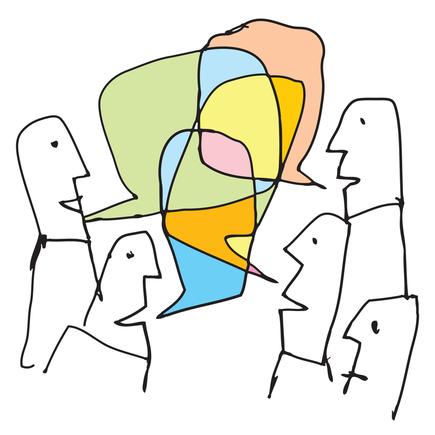
My previous two columns dealt with the Challenge of Networking and the Surprising Power of Weak Ties and An Unexpected and Scientifically Proven Way to Prepare
This third part, covers two powerful practical and easy to implement ways to make it easier to connect with people and continue to build your network of weak ties:
- The secret to great conversations
- What to do after the conversation
The secret to great conversations
Curiosity is the key to great conversations. Curiosity is the key that unlocks connection. Being interested is good – far better than not interested. But it’s curiosity that will make the huge difference. The easiest way is to take the approach that there is something I can learn from this person…and find out what it is.
People love to talk about themselves. Perhaps not surprising when you find out that research finds that talking about yourself triggers changes in the reward centre of the brain that are similar to those that occur during sex or when eating food[1].
So turn the spotlight on them. Your goal is to uncover a strong interest or a passion.
Ask with curiosity. Then use follow up questions to peel away the layers to really understand what that interest or passion means to them.
Read more: IT is the business
How do I do that?
A useful framework is:
- Break the ice
- Lead into something about them and their life
- If/When you’ve connected try to find out one or more of their strong interests or passions
- How are you finding the “conference/event”?
- What’s the best session you’ve been to so far?
- Is there a session you’re particularly looking forward to? … That’s interesting; tell me more about that…
- Where are you from?
Firstly break the ice with something open and general
Read more: CIO Upfront: The terror of the 'Frankencloud'
Then lead into finding out something about them and their life
Followed by: Are you from there originally?
And if it’s not the same place: So how did you end up going from "original place" to "current place?”
This will help uncover some great information to ask further questions and possibly a very interesting personal story to go with it.
Best never to ask “What do you do for a job?” It boxes people in and can make for an uncomfortable situation if they are between jobs
It that’s gone well and you feel you’ve now connected, then a great way to uncover some of their real interests, and possibly a passion, is to ask:
The magic of this question is that it’s non-threatening, open ended (not needing a yes or no answer) and it will give you an entrée to something important for them. A topic that you can either identify with as common ground to discuss, or dig into to learn something new. It will give you the opportunity to come away, at the very least, stronger for the additional knowledge and more likely, as a result of your approach, with a connection to that person in a way most people never achieve. This is one of the best questions to ask when you meet someone new. It’s a shortcut to a rich conversation, to strip away the overburden of unfamiliarity to uncover the gems of connection below.
The CIO's secret to great conversations @campbell_such #strategy https://t.co/X8CsJWxr23
— CIO New Zealand (@CIO_NZ) March 4, 2016
Read more: Mission: Clarity in communication
Follow on questions are critical
With any of these questions the critical next step is to ask follow on questions – these are where you’ll find the gems of connection. A powerful and easy to remember approach is to ,
Two questions that are powerful for achieving that are:
- That’s interesting, tell me more about…
- What’s the story behind that?
- Send them a note via email or ideally a brief handwritten note - to let them know you enjoyed meeting them and would like to stay in touch.
- Connect on LinkedIn. Don’t send the standard “naked” request to connect. LinkedIn should be about solid connections for people you could talk to someone else about. In the personalised connection request, explain why you’d like to connect – i.e. “I met you at the xyz conference, enjoyed our discussion on “topic” and would like to stay in touch”
Read more: The ascent of analytics: A rundown
This is powerful because the word “story” slips them right into storytelling mode which really helps to increase rapport.
Another simple but powerful technique to both keep the conversation going and to get a deeper understanding, is to take the last two to three words of their last sentence and repeat it back with an upward pitch at the end to turn it into a question. It’s a potent way to show you’re listening, are interested and want to know more.
This also means you keep the focus on them and it stops you thinking about what you’re going to say next. You can do this multiple times to keep peeling the layers back and effortlessly keep the conversation flowing.
Ask all your questions with true curiosity. With a desire to understand them and what makes them who they are. If you don’t, it will unconsciously show through, they will pick up on it and you may find the conversation struggling to move along, like trying to walk in deep snow. Curiosity is the skis that will get you up on top of the snow and moving forward more easily.
Try asking someone you know well, the “what’s happening that’s exciting you?” question and you might just discover some things about them you never knew before.
I’ve tried but it’s not working
Recognise that sometimes a conversation just doesn’t work. You haven’t been able to find the interest or passion that helps you move things along. It could be: wrong timing (maybe they’ve something else going on in their life), a mismatch of personalities, any number of reasons. Time to move on.
Also it may be that you’d like to move on. To grab a coffee, talk to someone else or take a break to recharge (especially important if you’re an introvert).
How do I move on?
Realise that it’s always okay to move on and that provided you do it in a respectful and reasonable manner I can virtually guarantee they won’t be upset.
Just say something like: “Steven, it’s been great talking to you and I'd like to catch up with a few other people. It would be great to connect, do you have a card?…”. Ideally, use their name as part of the wrap up of the conversation. Then move on.
What to do after the conversation
Read more: Glen Willoughby: Today’s CIOs wield revolutionary tools
Immediately after the conversation:
Pull out a pen, turn their business card over and write down any relevant details from your conversation on the back of their business card – interests, hometown, education, family, pets, sports, charities, business organisations, community groups, favourite business or personal travel location etc. Anything that could help reconnect in a future conversation.
Later on, when you get back to base, so you’ll always have their details handy, put their details along with any notes you made on the back of their card, into whatever contacts system you use – Outlook, Gmail, Evernote etc.
In the next few days:
- Send them a note via email or ideally a brief handwritten note - to let them know you enjoyed meeting them and would like to stay in touch.
- Connect on LinkedIn. Don’t send the standard “naked” request to connect. LinkedIn should be about solid connections for people you could talk to someone else about. In the personalised connection request, explain why you’d like to connect – i.e. “I met you at the XYZ conference, enjoyed our discussion on 'topic' and would like to stay in touch.”
Periodically:
Touch base by adding value for them. A good way to do this is to keep an eye out for something that they would find useful or is in their range of interests. When you spot something relevant, email them a link to a blog post, article (such as this one), book, website, - either personal or business related. This is where the notes from the back of the business card come in handy.
Take the long view of the relationship, don’t make it transactional, and don’t go in with any expectation of something in return. This is where the strength of this lies. Not with any expectation now…but building the weak ties that might mean a connection to something that can transform your life later in a way you couldn’t possibly imagine.
So to summarise the three parts:
A network of “weak ties” is one of the best things you can have.
Most of us feel that prickly sensation when we’re heading to a function, event or a conference, when you know you’re going to have to meet and talk with people…However pushing past it and connecting with people is worth it.
Make it easier to push past the uncomfortableness and build your network by:
- Using two minutes of power poses before an event or meeting
- Asking with curiosity and using targeted follow up questions to uncover the gems of connection.
- Taking a long term view of your relationships.
- Keeping in touch the smart way by periodically sending them information (or some thing) that they would find useful or is in their range of interests
Keep talking to strangers, keep asking with curiosity, keep adding value for your contacts and don’t be surprised when you start to see two or three degrees of separation delivering unexpected, positive outcomes in your life too…

Campbell Such is GM IT for Bidvest, a wholesale food distribution business and a top 50 company in NZ. He has a varied career in New Zealand and internationally, working in technology, management and roles in marketing and sales. Reach him at Campbell.such@bidvest.co.nz and through his blog.
Send news tips and comments to divina_paredes@idg.co.nz
Follow Divina Paredes on Twitter: @divinap
Follow CIO New Zealand on Twitter:@cio_nz
Click hereto read digital editions of CIO New Zealand
Sign up for CIO newsletters for regular updates on CIO news, views and events.
Join the CIO New Zealand group on LinkedIn. The group is open to CIOs, IT Directors, CDOs, COOs, CTOs and senior IT managers.
Join the CIO New Zealand group on LinkedIn. The group is open to CIOs, IT Directors, COOs, CTOs and senior IT managers.
